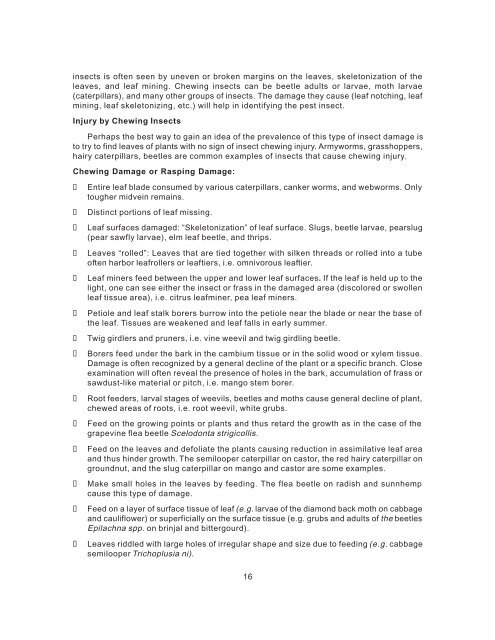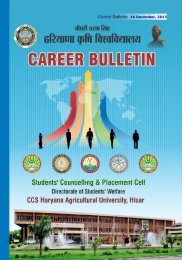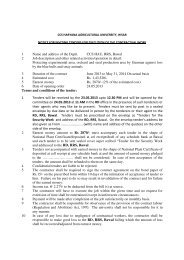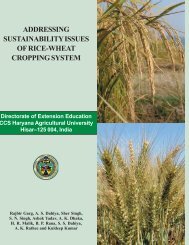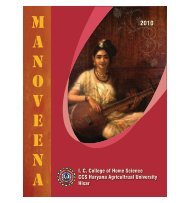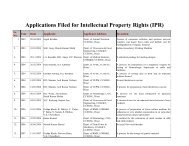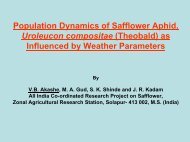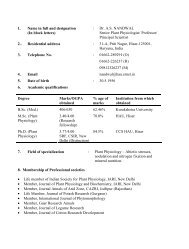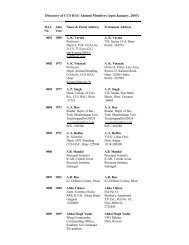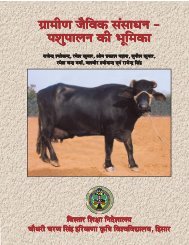Foreword - CCS HAU, Hisar
Foreword - CCS HAU, Hisar
Foreword - CCS HAU, Hisar
Create successful ePaper yourself
Turn your PDF publications into a flip-book with our unique Google optimized e-Paper software.
insects is often seen by uneven or broken margins on the leaves, skeletonization of the<br />
leaves, and leaf mining. Chewing insects can be beetle adults or larvae, moth larvae<br />
(caterpillars), and many other groups of insects. The damage they cause (leaf notching, leaf<br />
mining, leaf skeletonizing, etc.) will help in identifying the pest insect.<br />
Injury by Chewing Insects<br />
Perhaps the best way to gain an idea of the prevalence of this type of insect damage is<br />
to try to find leaves of plants with no sign of insect chewing injury. Armyworms, grasshoppers,<br />
hairy caterpillars, beetles are common examples of insects that cause chewing injury.<br />
Chewing Damage or Rasping Damage:<br />
Entire leaf blade consumed by various caterpillars, canker worms, and webworms. Only<br />
tougher midvein remains.<br />
Distinct portions of leaf missing.<br />
Leaf surfaces damaged: “Skeletonization” of leaf surface. Slugs, beetle larvae, pearslug<br />
(pear sawfly larvae), elm leaf beetle, and thrips.<br />
Leaves “rolled”: Leaves that are tied together with silken threads or rolled into a tube<br />
often harbor leafrollers or leaftiers, i.e. omnivorous leaftier.<br />
Leaf miners feed between the upper and lower leaf surfaces. If the leaf is held up to the<br />
light, one can see either the insect or frass in the damaged area (discolored or swollen<br />
leaf tissue area), i.e. citrus leafminer, pea leaf miners.<br />
Petiole and leaf stalk borers burrow into the petiole near the blade or near the base of<br />
the leaf. Tissues are weakened and leaf falls in early summer.<br />
Twig girdlers and pruners, i.e. vine weevil and twig girdling beetle.<br />
Borers feed under the bark in the cambium tissue or in the solid wood or xylem tissue.<br />
Damage is often recognized by a general decline of the plant or a specific branch. Close<br />
examination will often reveal the presence of holes in the bark, accumulation of frass or<br />
sawdust-like material or pitch, i.e. mango stem borer.<br />
Root feeders, larval stages of weevils, beetles and moths cause general decline of plant,<br />
chewed areas of roots, i.e. root weevil, white grubs.<br />
Feed on the growing points or plants and thus retard the growth as in the case of the<br />
grapevine flea beetle Scelodonta strigicollis.<br />
Feed on the leaves and defoliate the plants causing reduction in assimilative leaf area<br />
and thus hinder growth. The semilooper caterpillar on castor, the red hairy caterpillar on<br />
groundnut, and the slug caterpillar on mango and castor are some examples.<br />
Make small holes in the leaves by feeding. The flea beetle on radish and sunnhemp<br />
cause this type of damage.<br />
Feed on a layer of surface tissue of leaf (e.g. larvae of the diamond back moth on cabbage<br />
and cauliflower) or superficially on the surface tissue (e.g. grubs and adults of the beetles<br />
Epilachna spp. on brinjal and bittergourd).<br />
Leaves riddled with large holes of irregular shape and size due to feeding (e.g. cabbage<br />
semilooper Trichoplusia ni).<br />
16


